


GERD.....Sounds like something bad doesn't it?? GERD is an abbreviation for gastroesohageal reflux disease. It describes a number of symptoms and issues that can occur when the esophagus becomes irritated by stomach acid when it spills back into the esophagus. As we all know, the stomach is the holding chamber for what we eat. It produces acid and is able to churn the food, acid, and mucous together to begin the process of digestion. The stomach is protected from the acid by the mucous that it produces. The way the food gets from the mouth to the stomach is through the esophagus. The esophagus is a tubular structure that is covered with cells that are not capable of protecting themselves from acid. Where the stomach and esophagus come together is called the esophago-gastric junction (EG junction). This is where the esphagus leaves the chest and enters the abdomen. It is supposed to be an area of higher pressure and an angle that prevents reflux of stomach contents from the stomach into the esophagus. This image may help you understand.....
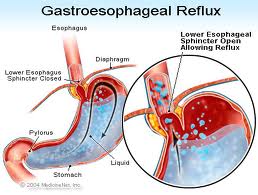 Reflux can happen to all of us. The symptom of the problem is "heart burn". Belching stomach contents into the esophagus exposes the lining of the esophagus to acid causing discomfort and at times, severe pain that can be severe enough to be mistaken for a heart attack.
Reflux can happen to all of us. The symptom of the problem is "heart burn". Belching stomach contents into the esophagus exposes the lining of the esophagus to acid causing discomfort and at times, severe pain that can be severe enough to be mistaken for a heart attack.
For most of us, this is an infrequent event and we take a Tums and it is just a bad memory. For others, it can become a daily problem that alters their life. Often, it is associated with a hiatal hernia. This is a widening of the hole in the diaphragm where the esophagus leaves the chest.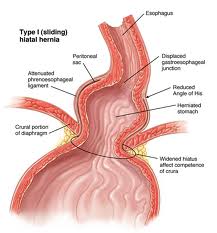 To treat this problem, in most cases, there are medications that can control it. Many times, medication can eliminate the symptoms and make the problem manageable. If not controlled, some may develope scar tissue that can lead to stricture. Others can have cellular changes that can increase cancer risk...it is a problem that should not be ignored.
To treat this problem, in most cases, there are medications that can control it. Many times, medication can eliminate the symptoms and make the problem manageable. If not controlled, some may develope scar tissue that can lead to stricture. Others can have cellular changes that can increase cancer risk...it is a problem that should not be ignored.
What happens if medications don't work?? GERD and hiatal hernia can be treated surgically. When treated this way, the problem is usually cured. The procedure we use is called a fundoplication. We tighten the opening in the diaphragm then wrap the upper part of the stomach around itself to re-create the angle at the end of the esophagus stopping the reflux.
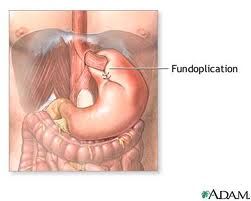 I do the procedure laparoscopically with five small incisions. In rare cases it may require open surgery.
I do the procedure laparoscopically with five small incisions. In rare cases it may require open surgery.
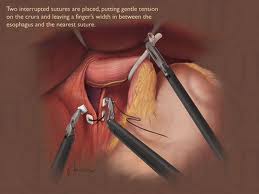
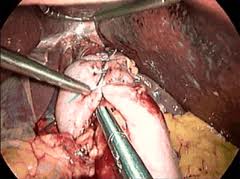 Hospital stay for this procedure is a couple of days and recovery time is fairly short.
Hospital stay for this procedure is a couple of days and recovery time is fairly short.
Hopefully this will give you some insight into a common disease, how to treat it medically and surgically. See your Doctor for treatment and if you need a surgical option....come see us at Total Body Surgical where we can help.
